
Kimbap
Kimbap is a classic Korean seaweed rice roll filled with seasoned beef, colorful vegetables, omelette strips, and pickled daikon. It‘s so popular in Japan to pack for lunch, picnics, and a meal on the go! Learn to make gorgeous seaweed rolls with my step-by-step guide.
Ingredients
For the Rice
- 2¼ cups uncooked Japanese short-grain white rice (3 rice cooker cups, 540 ml; yields 6⅔ cups or 990 g of cooked rice)
- 2½ cups water (540 ml)
For the Filling
- ¾ lb thinly sliced beef (such as ribeye) (found at Japanese or Korean grocery stores, or you can thinly slice meat at home)
- 2 Tbsp soy sauce (for the beef)
- 2 tsp sugar (for the beef)
- 4 cloves garlic (divided; for the beef and spinach)
- 2 large eggs (50 g each w/o shell)
- 3 pinches Diamond Crystal kosher salt (divided; for the eggs, carrots, and spinach)
- 1 Tbsp neutral oil (for cooking the omelette)
- 1 carrot (large; 5.6 oz, 160 g)
- 1 bunch spinach (roughly ½ lb, 250 g)
- 1 takuan (pickled daikon radish) (whole; about the length of a nori sheet)
- 4 Tbsp toasted sesame oil (divided; for cooking the vegetables and brushing the rolls; plus more as needed)
For Rolling the Kimbap
- 6 sheets nori (dried laver seaweed)
- 2 Tbsp toasted white sesame seeds
Instructions
- Gather all the ingredients. I recommend following the order of my preparation steps. If you start with the lightly-seasoned ingredients and end with the heavily-seasoned ingredients, then you don‘t have to wash the frying pan until you finish cooking everything.

To Cook the Rice
- Wash and Rinse: Add 2¼ cups uncooked Japanese short-grain white rice to a large bowl. Add enough cold tap water to wet the rice, then drain. Use your fingers to gently agitate and “wash“ the wet rice grains in a circular motion for 10–15 seconds. Add water to the bowl to rinse, then immediately pour off the cloudy water. Repeat this wash and rinse step two more times or until the water is almost clear. Then, drain the rice well in a fine-mesh sieve and shake off any excess water.
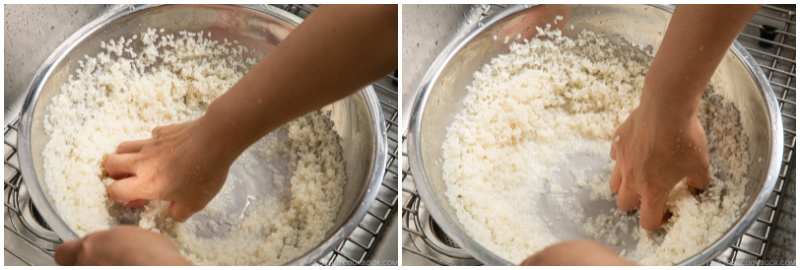
- Soak and Cook: Transfer the well-drained rice to the inner pot of a rice cooker. Add 2½ cups water to the pot and level the rice. Let the rice soak in the water for 20–30 minutes. Then, start cooking. If you don‘t have a rice cooker, you can cook the rice in a pot on the stove, Instant Pot, or donabe. While the rice is soaking and cooking, prepare the filling ingredients.
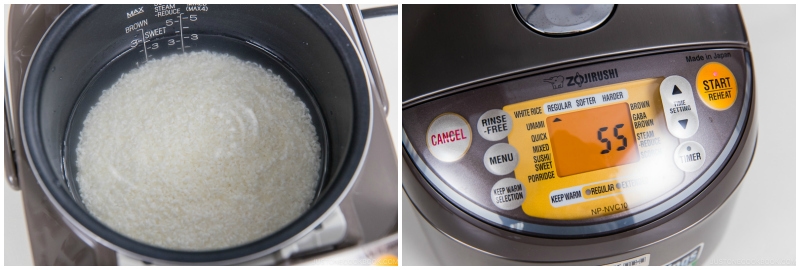
To Prepare the Filling
- Beef: In a medium bowl, combine the marinade ingredients: 2 Tbsp soy sauce, 2 tsp sugar, and 2 cloves garlic, crushed or minced (I use a garlic press). Mix it all together to dissolve the sugar.
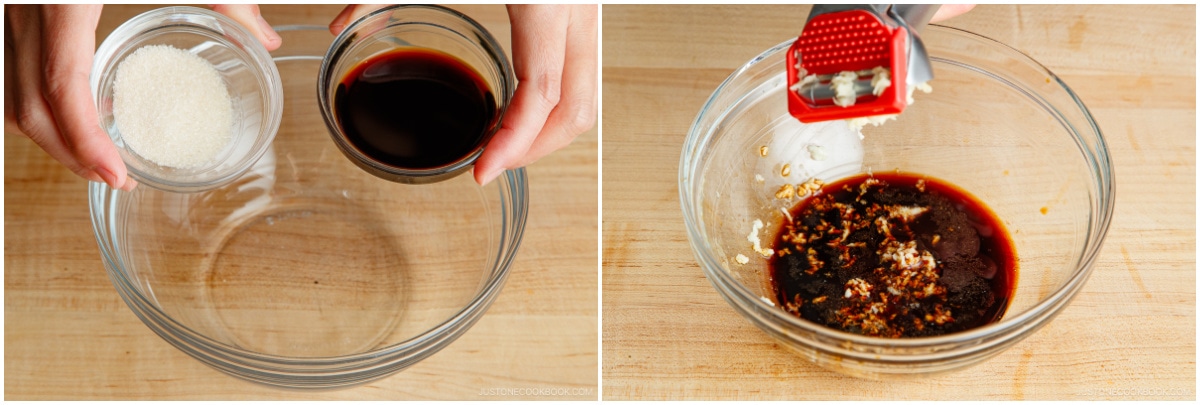
- Slice ¾ lb thinly sliced beef (such as ribeye) crosswise into pieces 3 inches (7.6 cm) wide. Add the beef to the marinade. Mix gently to separate the slices and thoroughly coat them with the seasonings. Set aside to marinate until you‘re ready to cook. Meanwhile, prepare the other ingredients.
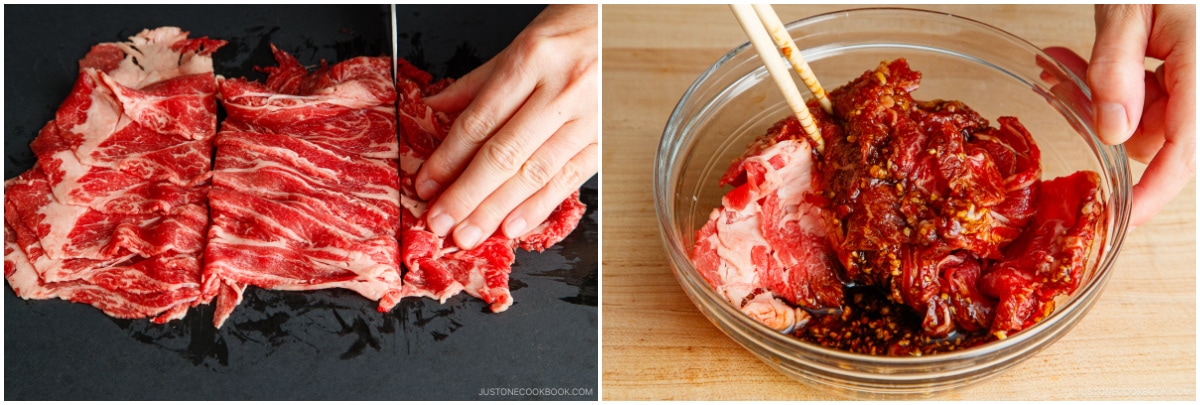
- Omelette: Crack 2 large eggs (50 g each w/o shell) into a bowl. Add 1 pinch Diamond Crystal kosher salt, then gently whisk. Do not overmix.
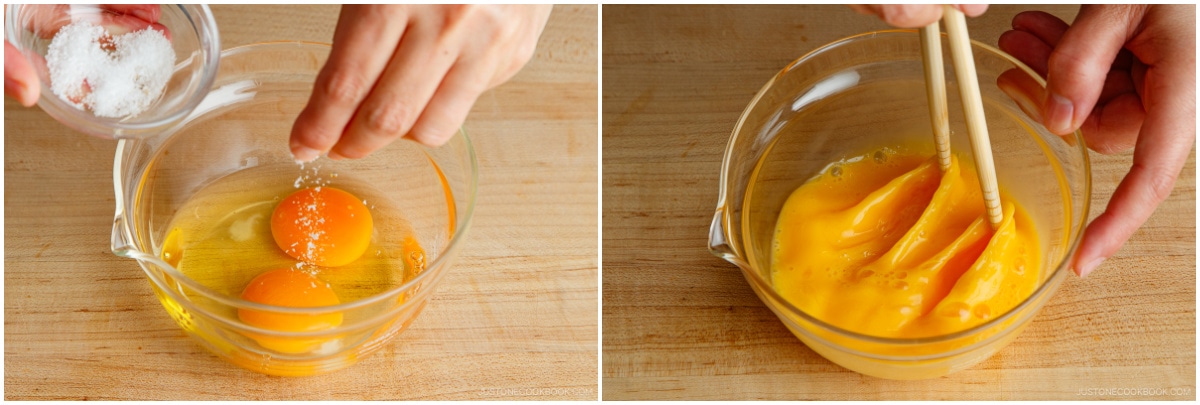
- Heat a frying pan (I use an 11" carbon steel pan) over medium heat. Then, add 1 Tbsp neutral oil to the pan. To check if the pan is hot enough, put a drop of the egg mixture in the pan. When you hear a sizzling sound, it‘s ready.

- Pour the egg mixture into the pan. (If you‘re doubling the recipe, cook one omelette at a time.) Quickly tilt the pan to coat the entire cooking surface with the egg. As the egg cooks, poke any air bubbles to release the air.
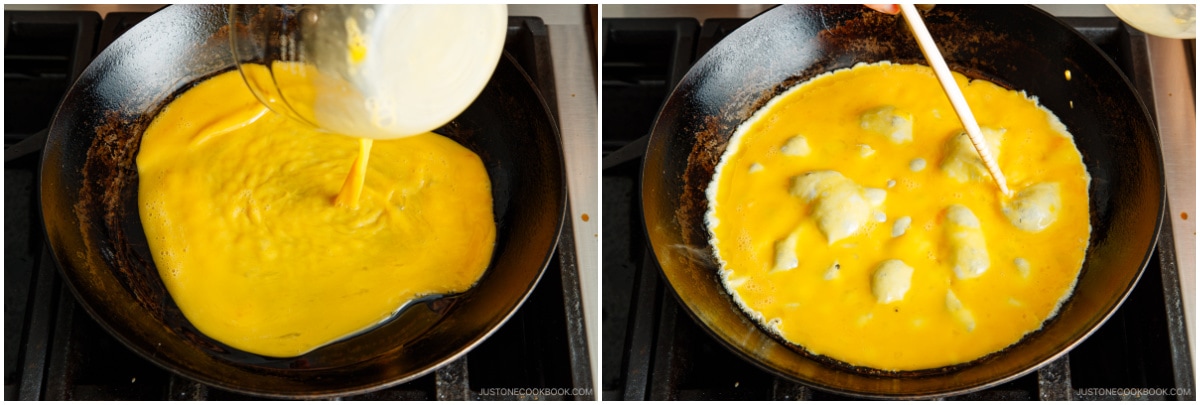
- Cook until the bottom of the egg is just set but not browned, about 2 minutes. Then, flip over the egg with a spatula and cook for another 2 minutes.
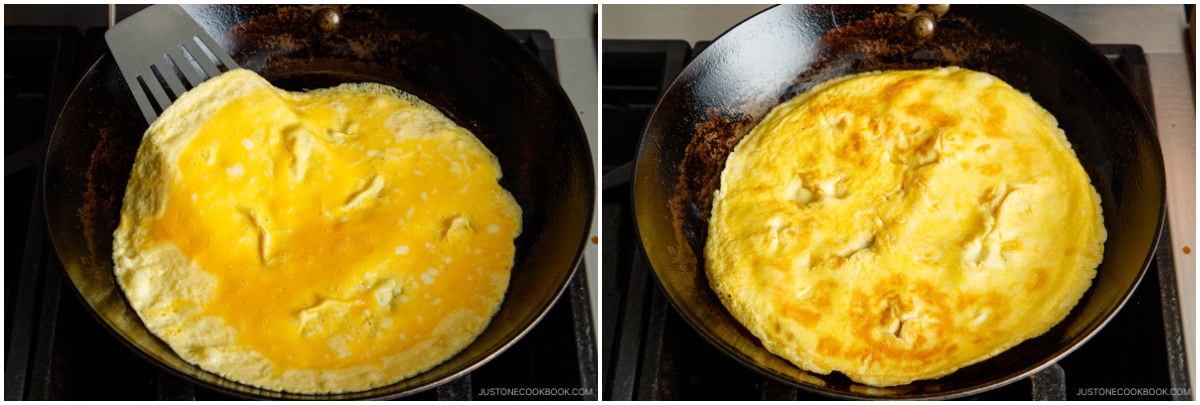
- Transfer the omelette to a plate and let cool. Cut it into strips ½ inch (1.3 cm) wide. I folded the omelette in half before slicing to help cut the strips a uniform width. Place on a tray or plate.
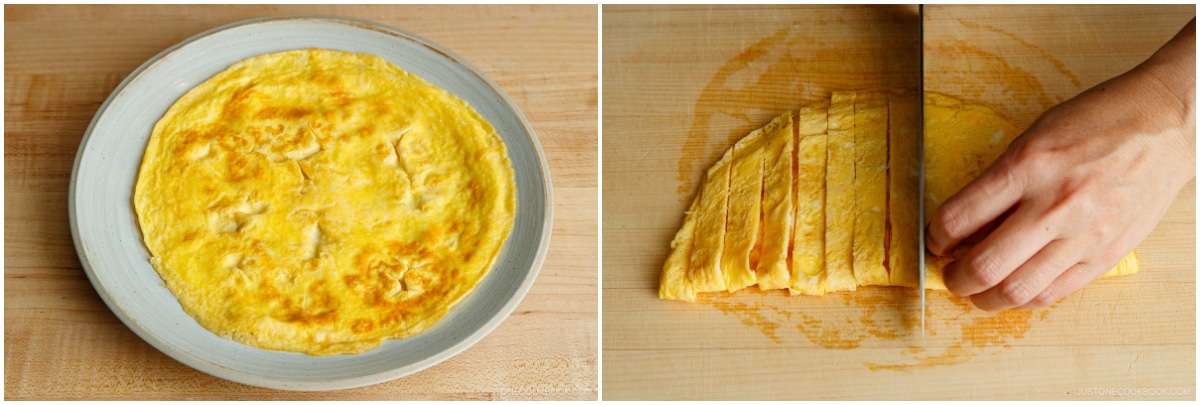
- Carrot: Peel 1 carrot, then shred into fine strips about 3–4 inches (7.5–10 cm) long using a julienne peeler.
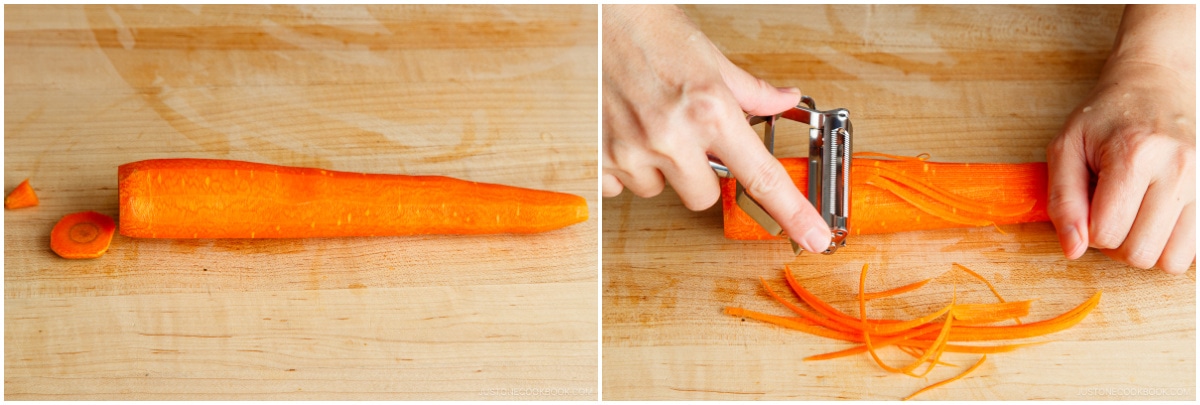
- Alternatively, you can use your knife to make julienned strips. Cut the carrot into sections about 3–4 inches (7.5–10 cm). Next, cut them lengthwise into ⅛–inch slabs. Stack these slabs and cut lengthwise into ⅛-inch strips.
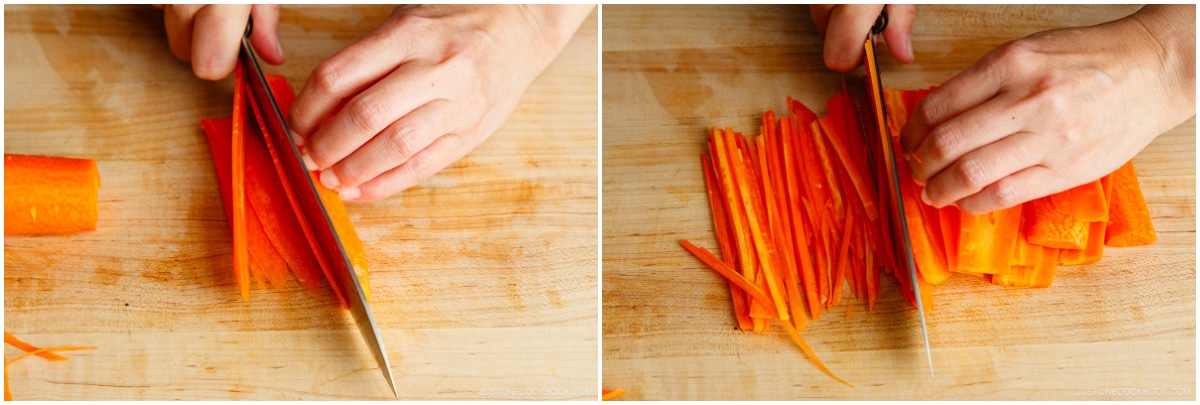
- Heat the same pan that you just used (without washing) over medium heat and add 1–3 tsp toasted sesame oil. When the oil is hot, add the carrot and 1 pinch Diamond Crystal kosher salt. Sauté until tender. Transfer to the plate or tray and let cool.
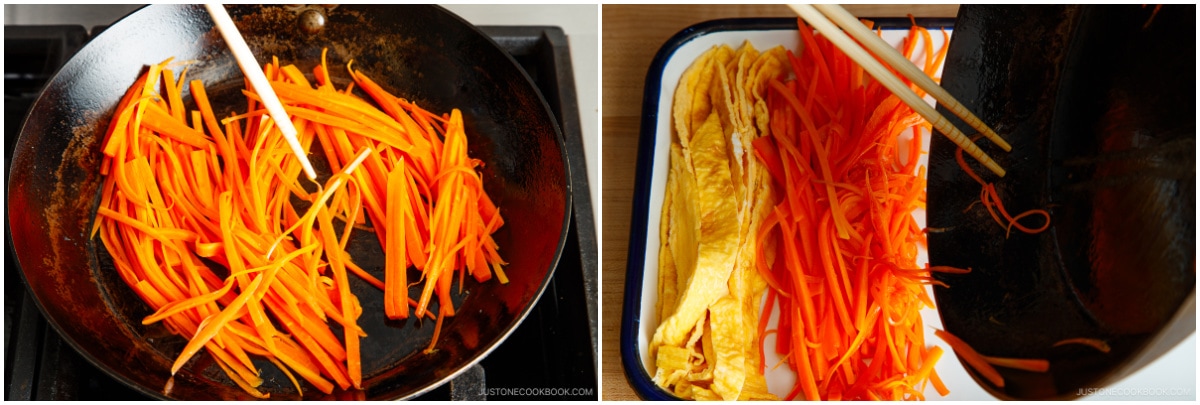
- Spinach: Trim off a bit of the stem end of 1 bunch spinach. Cut the spinach in half crosswise to separate the leafy and stem parts.
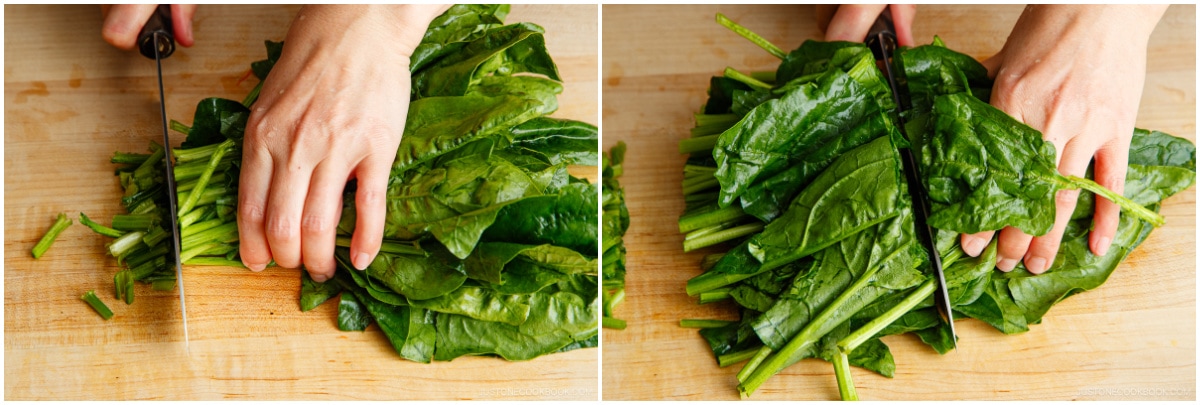
- Heat the same pan over medium heat and add 1–3 tsp toasted sesame oil. Add the bottom stem half of the spinach and 2 cloves garlic, minced or crushed (I use a garlic press).
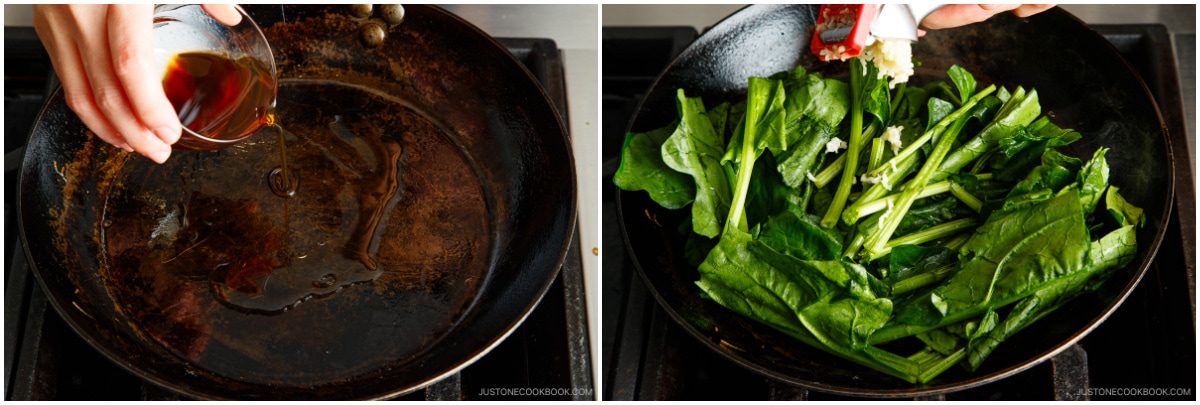
- Sauté until wilted. Then, add the top leafy half of the spinach and 1 pinch Diamond Crystal kosher salt. Sauté again until wilted, then transfer to the plate or tray and let cool.
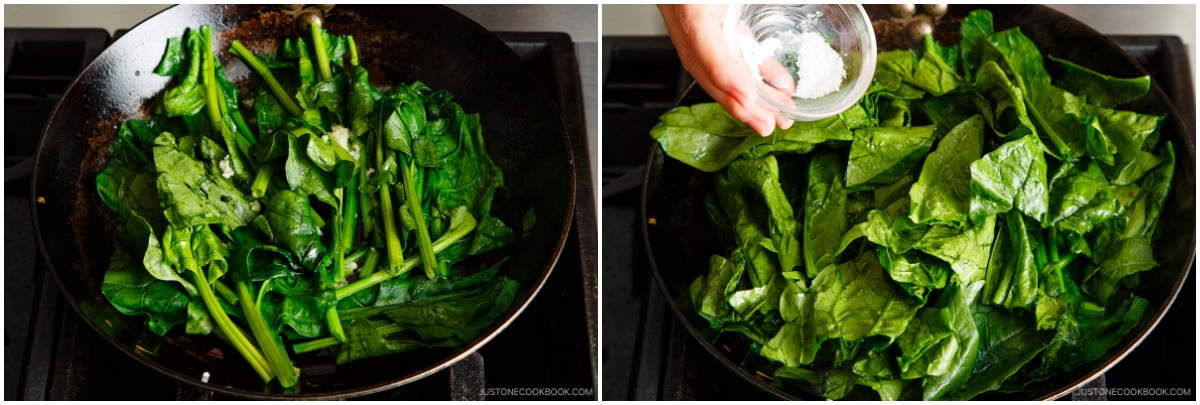
- Beef: Heat the same pan over medium heat and add 1–3 tsp toasted sesame oil. When it‘s hot, add the marinated beef and marinade.
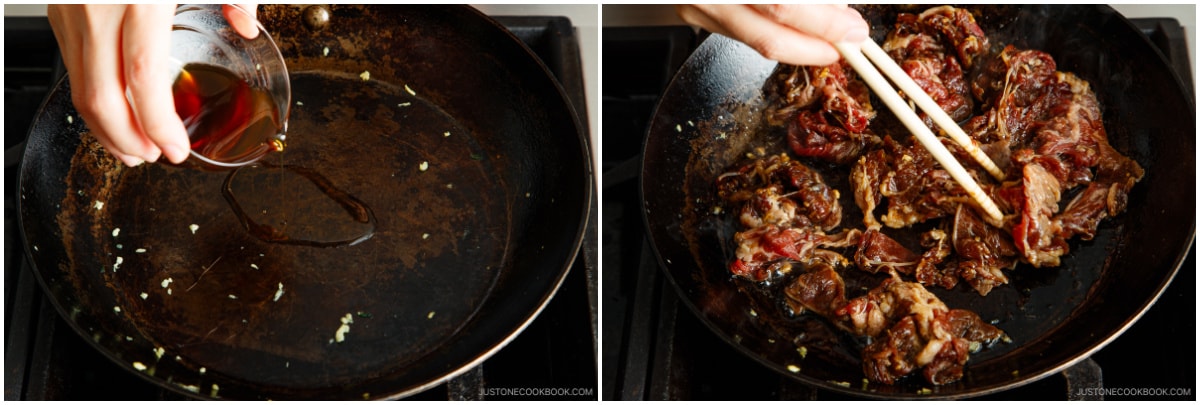
- Sauté until the beef is cooked through and all the moisture has evaporated. Transfer to the plate or tray with the vegetables to let cool.
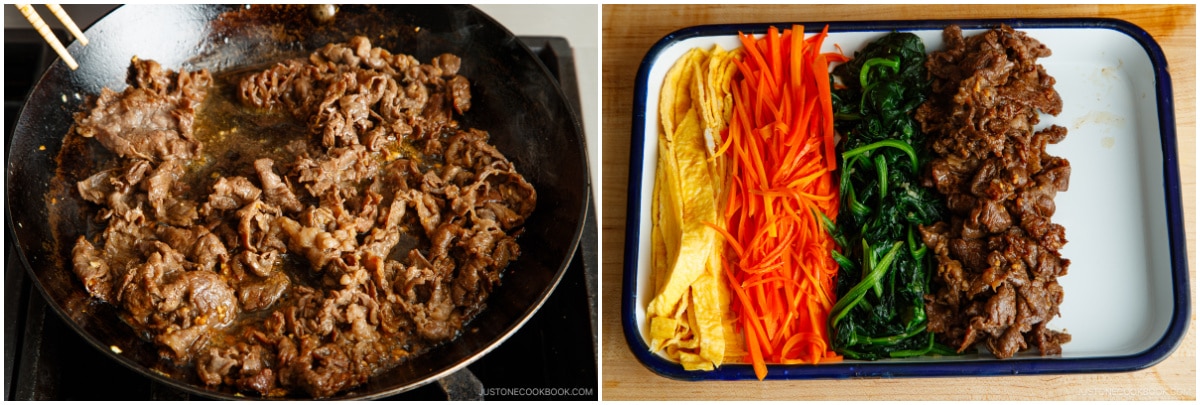
- Pickled daikon: Cut 1 takuan (pickled daikon radish) into long slabs ⅓ inch (8 mm) thick and the same length as the nori sheets. Then, cut the slabs into long sticks. Add it to the plate or tray with the other ingredients.
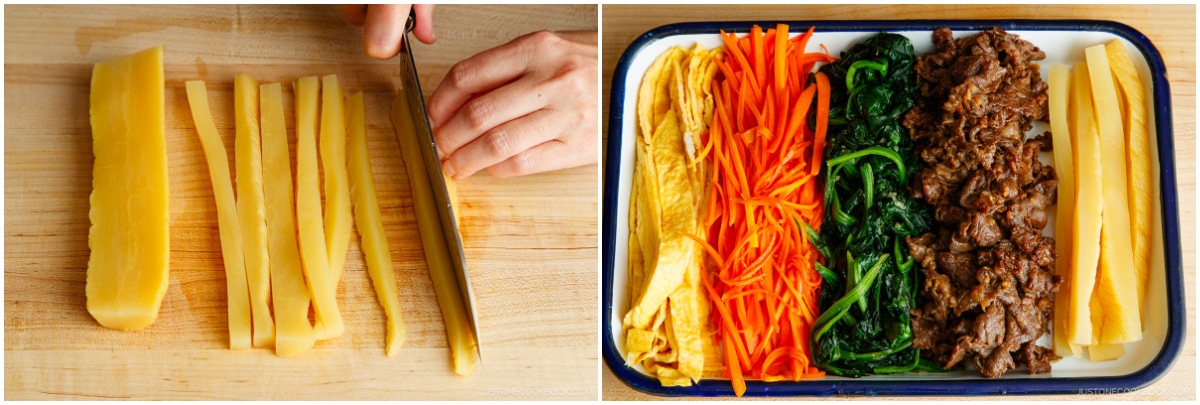
To Spread the Rice
- Prepare a tray (I use a quarter sheet baking pan) lined with parchment paper to hold the completed rolls. Also, prepare a 1-cup measuring cup and a small bowl of water.

- Gather 6 sheets nori (dried laver seaweed); we‘ll make one roll at a time. Nori has a rough surface (see the left sheet in the left image) on one side and a smooth surface (right sheet) on the other. With the rough side facing up, place one sheet of nori on a bamboo sushi mat so the lines embossed onto the nori are horizontal. Use them as a guide in the next step, when you‘ll spread the rice to about 1 inch (2.5 cm) from the sheet‘s top edge between the first and second lines; see where I‘m pointing (right image).
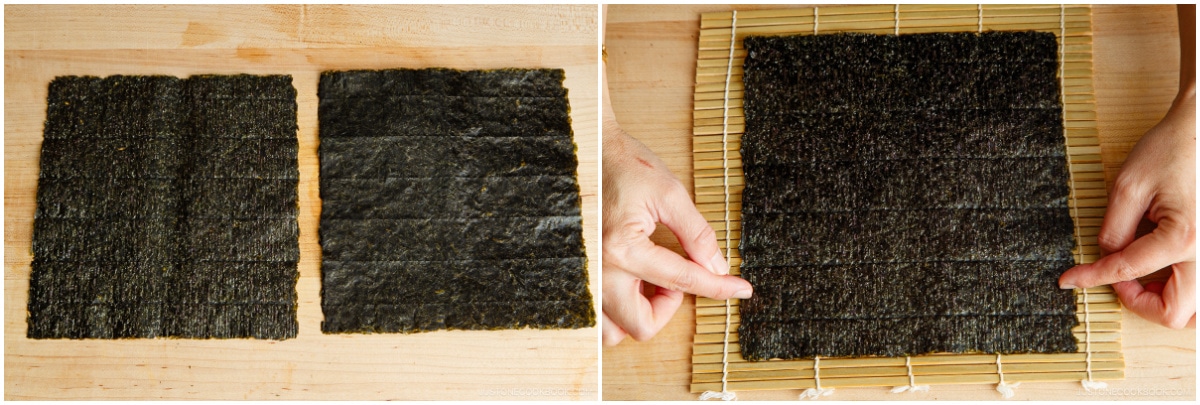
- Gently fluff the hot cooked rice with a rice paddle. Let the rice cool slightly until it‘s cool enough to handle. Dip the measuring cup in the bowl of water to wet it so the rice doesn‘t stick. Then, use it to measure 1 cup of rice; make sure it‘s a level scoop and not heaping.
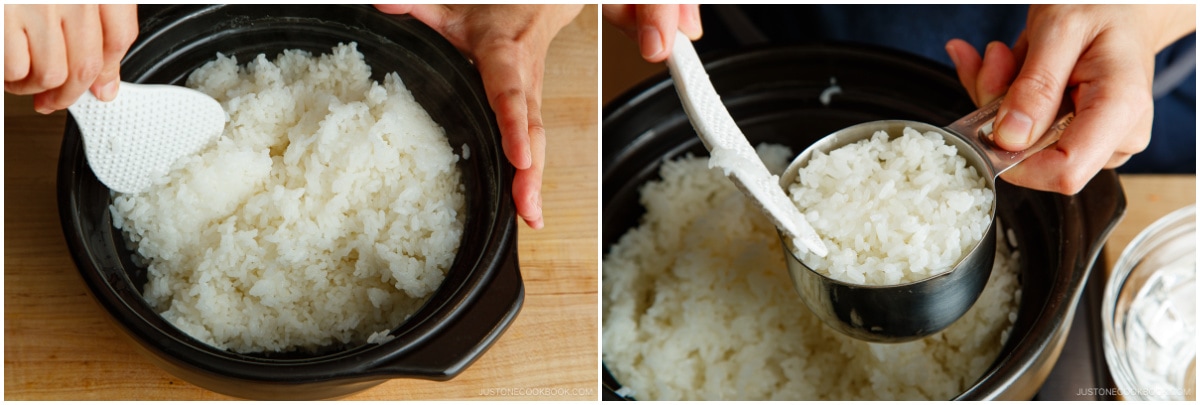
- Position the nori ½–1 inch (1.3–2.5 cm) above the bottom edge of the sushi mat, where you will hold with your fingers later. Transfer the measured rice onto the nori. Dip your fingertips in the bowl of water so the rice doesn‘t stick to them.

- Evenly spread the rice with your fingers to the bottom and side edges of the nori sheet and to within 1 inch (2.5 cm) of the top edge. Tip: Spread the rice in an even layer to achieve a uniform shape and thickness across your finished roll.
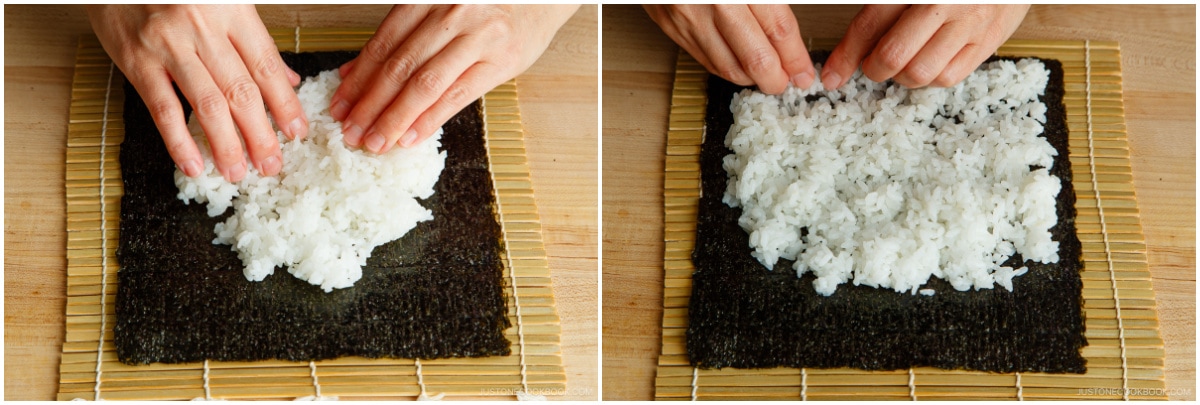
- Alternatively, you can spread the rice using a plastic rice paddle.
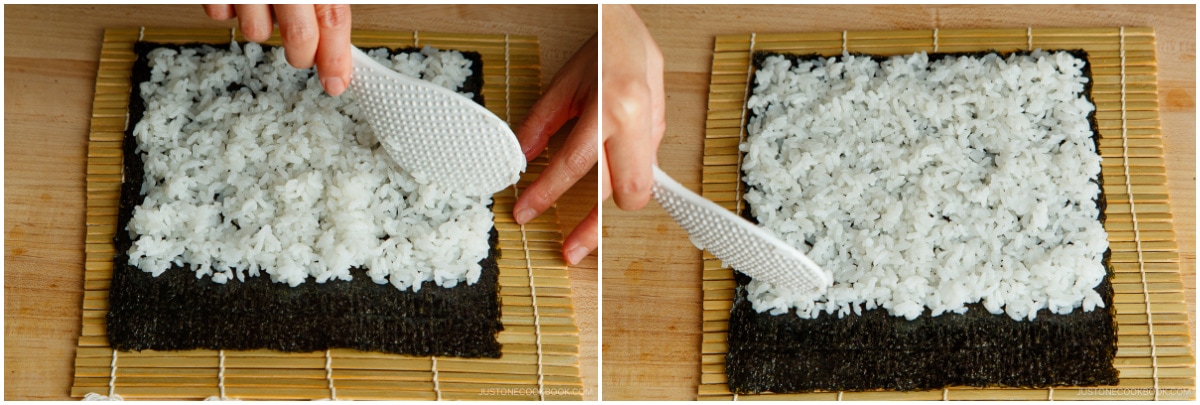
To Fill and Roll the Kimbap
- Now, add one portion of each filling to the center/middle of the rice, lining up the ingredients in strips across the width of the nori. Start with the smaller ingredients like the carrots and beef.
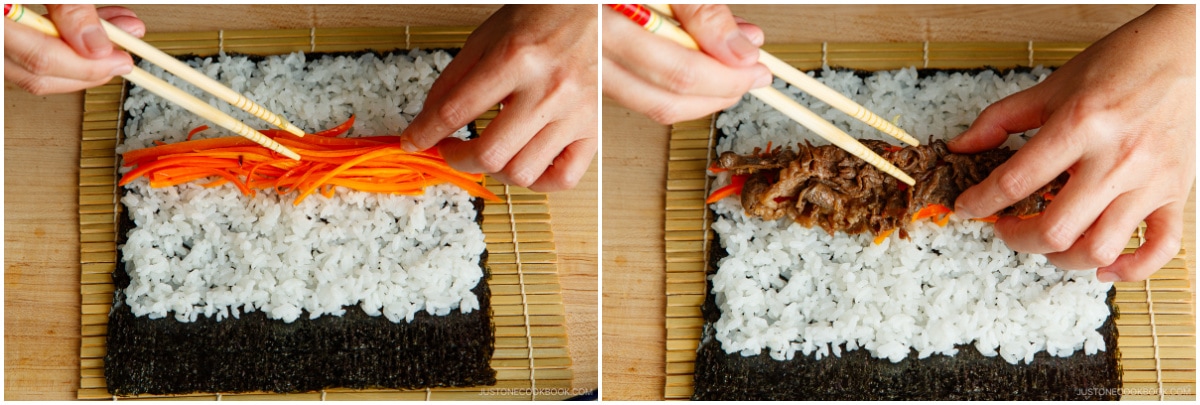
- Add the spinach. End with the easy-to-hold ingredients like the omelette strips and pickled daikon. Tip: Do your best to stack the ingredients onto each other neatly and evenly across the width of the nori. This helps to create an even thickness and uniform shape for your rolls.
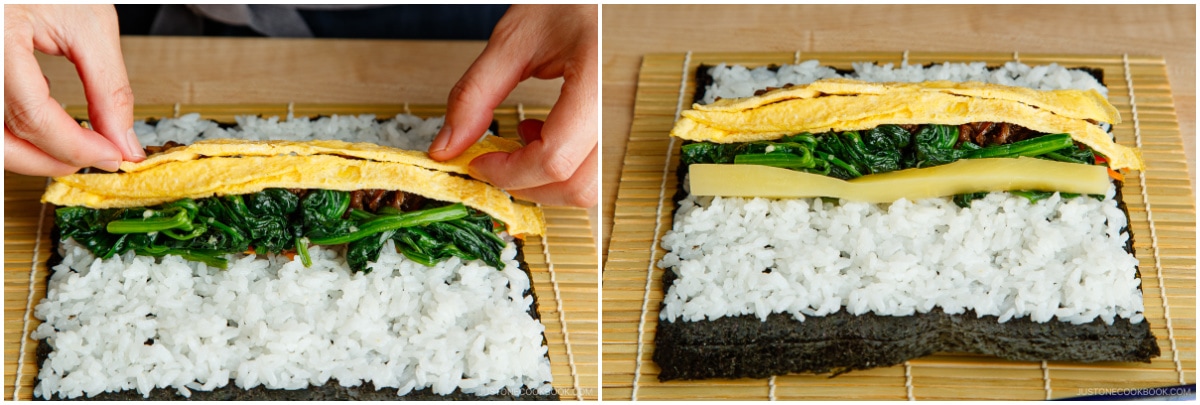
- Grab the bottom edge of the mat with your index fingers and thumbs while using your other fingers to hold the filling in place. Start rolling the bottom end of the nori sheet over the filling. Use the bamboo mat to roll tightly and firmly until the bottom edge of the rice meets the rice on the other side of the ingredients.
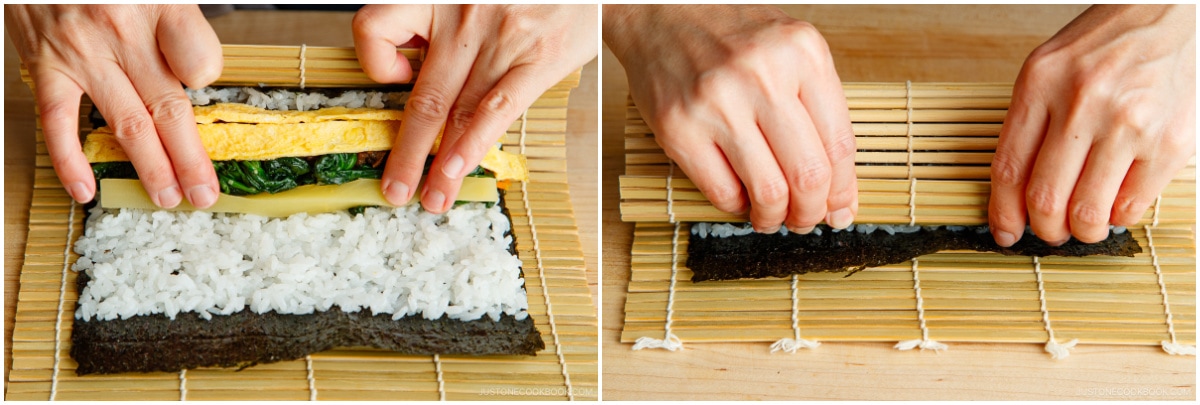
- Here‘s a side view of the edge being rolled up.
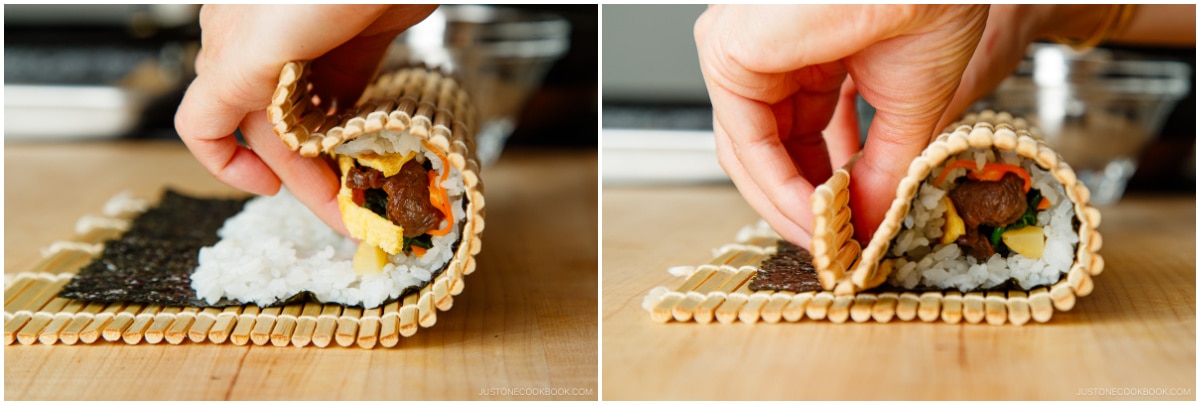
- With one hand, firmly hold the roll and mat down. With your other hand, grab the top end of the mat. Then, pull the two against and away from each other to tighten the roll. Start in the center, then repeat on the left and right sides.
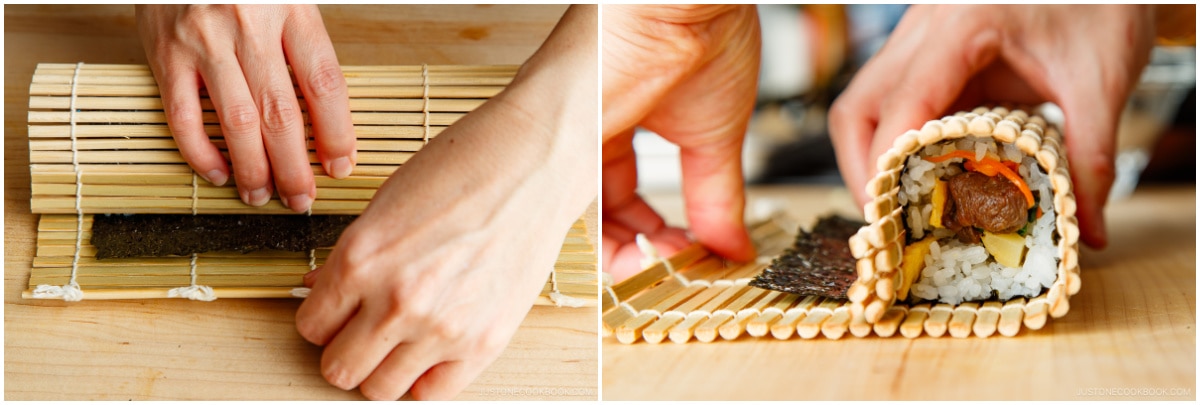
- Lift up the end of the mat off of the roll, then finish rolling the rest of the way.
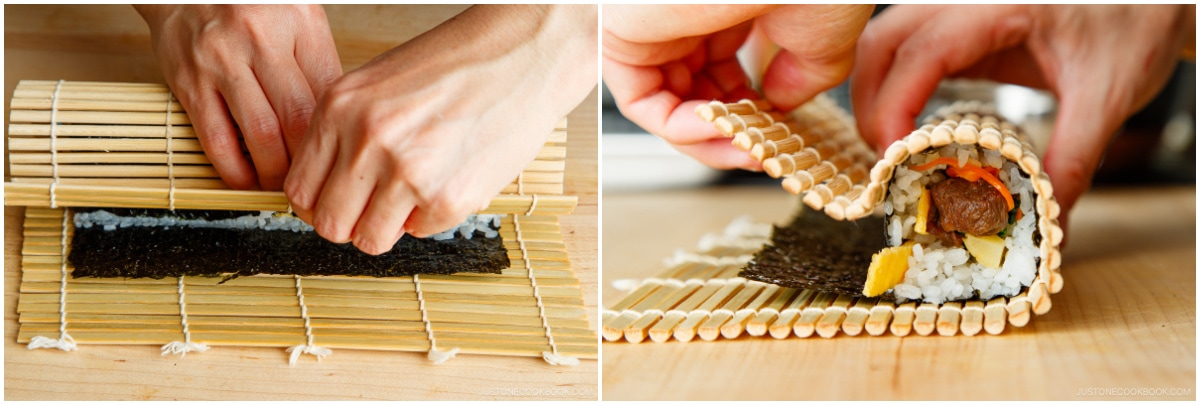
- Once you finish rolling, press firmly on top with your fingers to shape the roll evenly. Transfer the roll, seam side down, to the tray or baking sheet lined with parchment paper. Cover with plastic wrap to keep it from drying out as you continue to make the rest of the rolls.
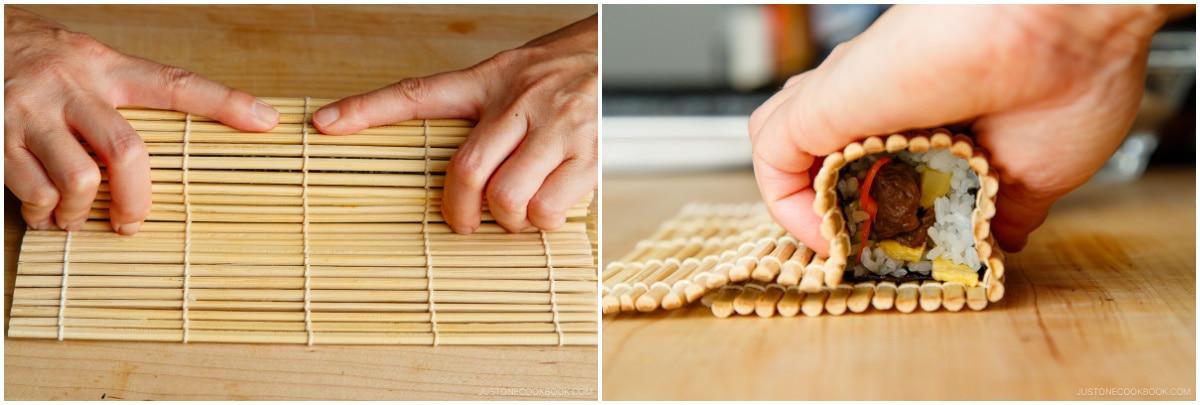
- Remove the plastic from the Kimbap. Brush the tops lightly with the remaining toasted sesame oil and sprinkle with 2 Tbsp toasted white sesame seeds on top.
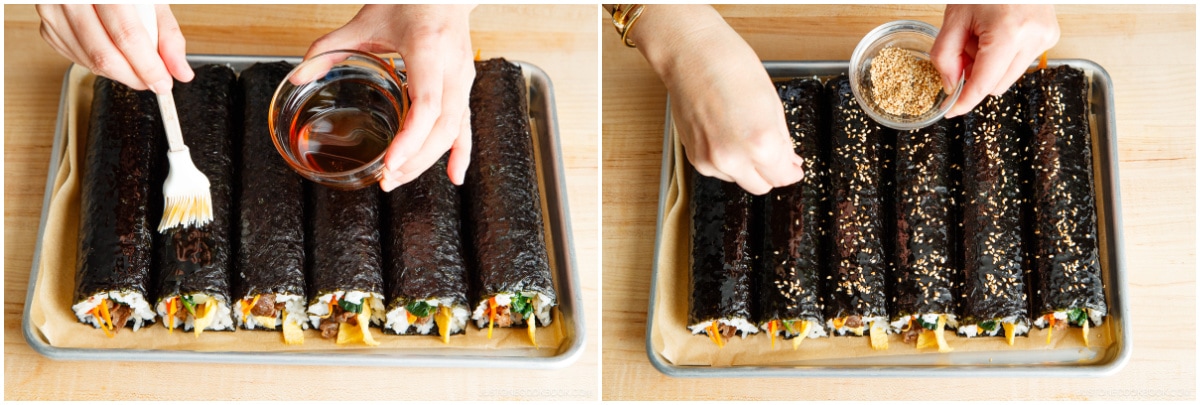
To Cut and Serve
- Using a very sharp knife, first cut the Kimbap in half crosswise. To make clean cuts, you can wipe the knife blade with a wet kitchen cloth after every several slices, as needed.
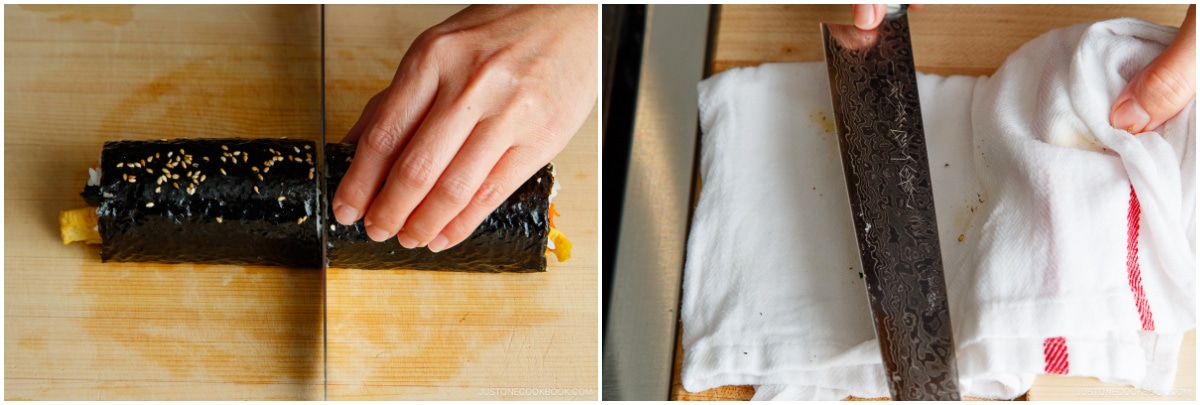
- Cut the halves in half, then cut the quarters in half. You will have 8 cut pieces per roll.
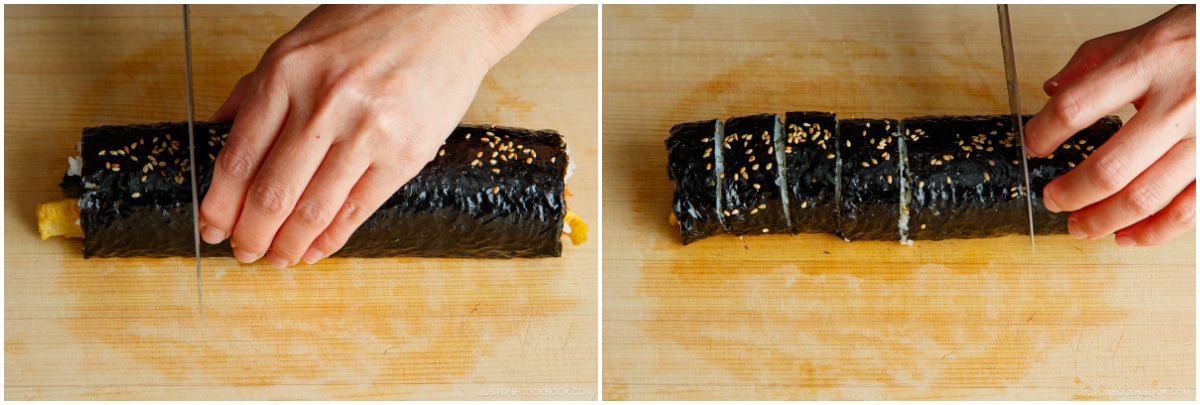
- I arrange the cut Kimbap stacked in a tower on a platter. Serve at room temperature. Enjoy!
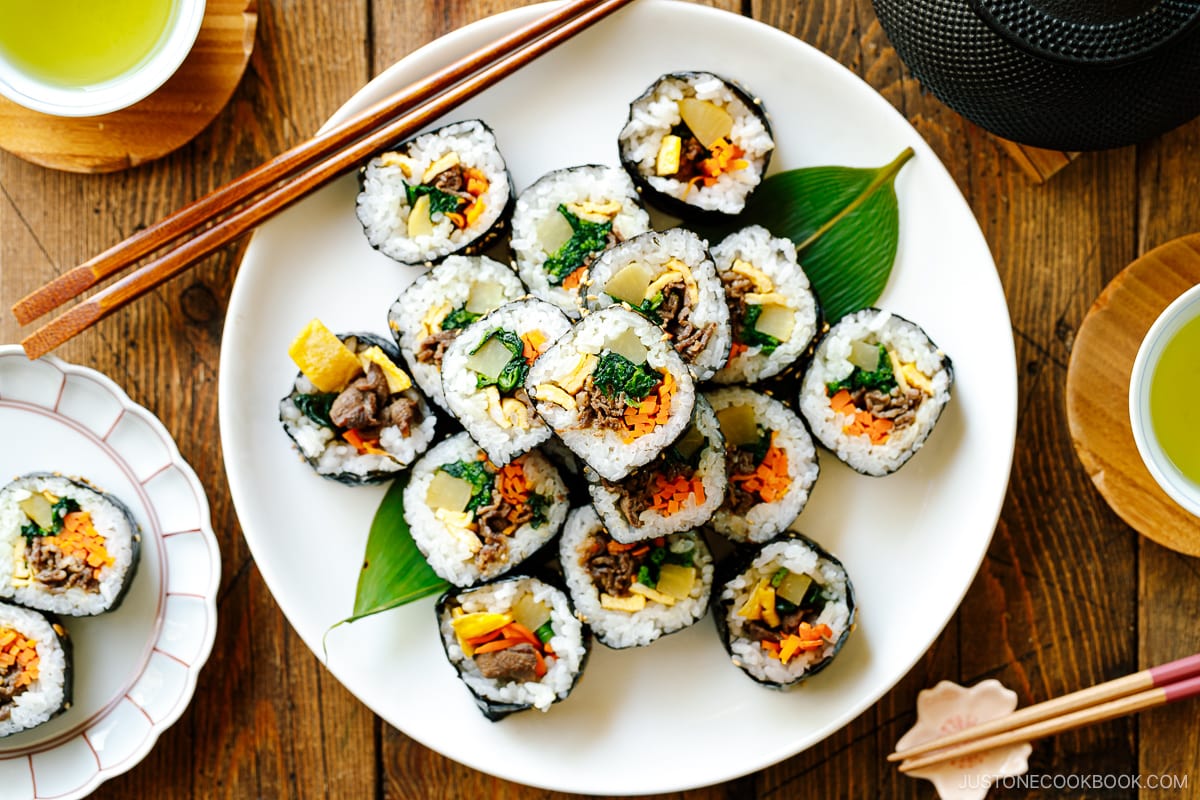
To Store
- It‘s best to enjoy the Kimbap the same day you make them. Like sushi, don‘t refrigerate kimbap unless you need to keep it for the next day, as rice gets hard and dry when cold. If you need to refrigerate them, I recommend that you wrap the Kimbap in plastic and then a thick kitchen towel, so the rice will stay cool and safe, but not get cold.
Nutrition
Calories: 870kcal, Carbohydrates: 142g, Protein: 25g, Fat: 21g, Saturated Fat: 5g, Polyunsaturated Fat: 6g, Monounsaturated Fat: 9g, Trans Fat: 0.02g, Cholesterol: 85mg, Sodium: 462mg, Potassium: 813mg, Fiber: 5g, Sugar: 5g, Vitamin A: 8588IU, Vitamin C: 30mg, Calcium: 158mg, Iron: 4mg